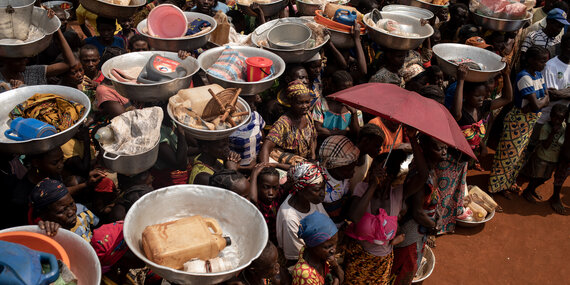Bangassou, Central African Republic
A crowd awaits the World Food Program's food distribution at the Siwa IDP site. OCHA/Adrienne Surprenant
Inter-Agency Coordinated Appeals for 2022
1 in 29 people worldwide needs help, which is yet another significant increase from 1 in 33 in 2020 and 1 in 45 in 2019. Needs continue to increase, driven by a confluence of political instability, increased displacement levels, climate impacts and the effects of COVID-19. Crises have expanded their geographical range within already weakened States. The spike in humanitarian need is also being driven by specific natural disasters, such as the earthquake in Haiti and Hurricanes Eta and lota in Central America. In Afghanistan, the worst drought in 27 years and the cumulative effects of more than four decades of conflict are severely affecting food security: even after the harvest, 57 per cent of households did not have sufficient food reserves for the next three months.
Evolution of People in Need (2015-2022)
The total requirements for the 2022 Global Humanitarian Overview have doubled in just four years. This year there are nine country plans with requirements above $1 billion: Afghanistan, DRC, Ethiopia, Nigeria, Somalia, South Sudan, Sudan, Syria and Yemen, as well as three regional plans over $1 billion total requirements (South Sudan RRP, Syria 3RP and Venezuela RMRP). In 2022, greater numbers of people will be targeted for assistance. Conflict, poverty, deepening food insecurity and other vulnerabilities have triggered coordinated appeals across 30 countries and 7 regions.
Evolution of appeals by size of requirements (2016-2022)
Two regions (the Middle East and North Africa, and West and Central Africa) continue to have the most humanitarian needs due to protracted crises that show no signs of abating. Over the past two years, sharp increases in needs are evident in Asia and the Pacific, Latin America and the Caribbean, and Southern and Eastern Africa. Five years ago, only Haiti had a HRP in Latin America and the Caribbean; now there are six in place across the region.
Despite increasing need, some countries, such as Chad and DRC, have reduced the number of people targeted in their response plans, introducing stricter prioritization processes to ensure that diminishing humanitarian capacities yield the maximum impact possible for the most vulnerable people. Welcome improvements have been seen in Libya, where the population has started to recover after the ceasefire agreement. Some countries have also weathered the COVID-19 crisis better than initially anticipated and recalculated the number of people in need accordingly.
In Afghanistan, more than 24 million people require life-saving assistance to prevent catastrophe. This represents a dramatic increase in needs, driven by a combination of conflict, COVID-19, political turmoil, recurrent economic shocks and the worst drought in 27 years. A decade into the crisis in Syria and basic service delivery continues to be vastly inadequate and hampered by damaged infrastructure, lack of critical supplies and, increasingly, financial unaffordability. Average household expenditure now exceeds available income by 50 per cent, compared to 20 per cent in August 2020.
Inter-Agency Coordinated Appeals: Overview per region
Despite continued efforts to mitigate the risk of famine in Yemen, food insecurity continues to remain a key challenge. Acute food insecurity is a reality for 16.2 million people in the country. Even with the current levels of humanitarian assistance, 40 per cent of the population have inadequate food. In Ethiopia, climate shocks, unprecedented levels of conflict, insecurity and disease outbreaks coupled with a deteriorating economy continue to exacerbate humanitarian needs for 25.9 million people. Many of the 4.3 million IDPs seek shelter in urban areas, further increasing pressure on vulnerable families within host communities.
People in Myanmar are facing an unprecedented political, human rights and humanitarian crisis, with needs escalating dramatically since the military takeover and a severe COVID-19 third wave in 2021. Humanitarian assistance is needed by 14.4 million people. In Haiti, 43 per cent of the population needs humanitarian assistance. The country is experiencing a profound and disturbing deterioration of the socioeconomic, political and security context coupled with the effects of the pandemic and a 7.2-magnitude earthquake that affected more than 800,000 people.
South Sudan is facing its highest levels of food insecurity and malnutrition since the country declared independence 10 years ago. Macroeconomic shocks, three years of consecutive flooding, disease outbreaks and increasing subnational violence have resulted in 8.4 million people in need and a growing number of threats against humanitarian workers.
References
-
All 2022 data is as estimated in November 2021. For current data, please visit https://hum-insight.info/





